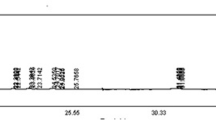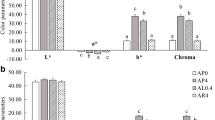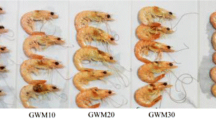Abstract
Functional foods have molecules that promote health benefits beyond their nutritional qualities. In this context, the zootechnical performance, color, and biochemical responses of Pacific white shrimp (Litopenaeus vannamei) fed with different levels of açaí (Euterpe oleracea), a fruit with unique antioxidant characteristics, were observed. Four diets with different levels of inclusion of lyophilized açaí (0.0%, 2.5%, 5.0%, and 10.0% W/W) were administered to shrimps reared in biofloc technology (BFT) systems. After 43 days, the zootechnical parameters (weight gain, feed conversion ratio, and specific growth rate) and coloration in fresh and cooked shrimps were measured, and the L*, a*, and b* parameters were estimated with a digital colorimeter. Survival and growth performances were not affected by açaí inclusion in diets. Açaí inclusion modulates the flavonoid content in the gills of L. vannamei and in the bioflocs of the rearing BFT system. As in the diet of 10.0% açaí, performed with a total replacement of fish oil without affecting growth, we propose the use of açaí as a vegetal oil source for shrimp feeding in BFT systems. Açaí also induced the reddish color in fresh and cooked L. vannamei, an influential factor in their commercial value.


Similar content being viewed by others
References
Aminot A, Chaussepied M (1983) Manuel des analyses chimiques en milieu marin. CNEXO, Brest
AOAC (2005) Official methods of analysis 16th ed. Association of Official Analytical Chemists. USA, Washington DC
APHA (American Public Health Association) (1998) Standard methods for the examination of water and wastewater. APHA, Washington
Avnimelech Y (2006) Bio-filters: the need for a new comprehensive approach. Aquac Eng 34:172–178
Avnimelech Y (2012) Biofloc technology–a practical guide book, 2nd edn. The World Aquaculture Society, Baton Rouge
Ayisi CL, Hua X, Apraku A et al (2017) Recent studies toward the development of practical diets for shrimp and their nutritional requirements. HAYATI J Biosci 24:109–117
Barbosa PO, Pala D, Silva CT, de Souza MO, do Amaral JF, Vieira RA, Folly GA, Volp AC, de Freitas RN (2016) Açai (Euterpe oleracea Mart.) pulp dietary intake improves cellular antioxidant enzymes and biomarkers of serum in healthy women. Nutrition 32:674–680
Burford MA, Thompson PJ, Mcintosh RP et al (2003) Nutrient and microbial dynamics in high-intensity, zero-exchange shrimp ponds in Belize. Aquaculture 219:393–411
De Lima Yamaguchi KK, Pereira LFR, Lamarao CV et al (2015) Amazon acai: chemistry and biological activities: a review. Food Chem 179:137–151
Dias ALS, Rozet E, Larondelle Y, Hubert P, Rogez H, Quetin-Leclercq J (2013) Development and validation of an UHPCL-LQT-Orbitrap MS method for nonanthocyanin flavonoids quantification in Euterpe oleracea juice. Anal Bioanal Chem 405:9235–9249
Emerenciano M, Gaxiola G, Cuzon G (2013) Biofloc technology (BFT): a review for aquaculture application and animal food industry. In: Darko Matovic M (ed) Biomass now-cultivation and utilization. IntechOpen Limited, London, pp 301–328
Erickson MC, Bulgarelil MA, Resurreccion AVA et al (2007) Consumer differentiation, acceptance, and demographic patterns to consumption of six varieties of shrimp. J Aquatic Food Products Technol 15:35–51
Ferreira DS, Gomes AL, da Silva MG et al (2016) Antioxidant capacity and chemical characterization of Açaí (Euterpe oleracea Mart.) fruit fractions. Food Sci Technol 4:95–102
Gajula D, Verghese M, Boateng J et al (2009) Determination of total phenolics, flavonoids and antioxidant and chemopreventive potential of basil (Ocimum basilicum L. and Ocimum tenuiflorum L.). Int J Can Res 5:130–143
Gaona CAP, Almeida MS, Viau V et al (2015) Effect of different total suspended solids levels on a Litopenaeus vannamei (Boone, 1931) BFT culture system during biofloc formation. Aquac Res 48:1070–1079
Gonzales GB, Smagghe G, Grootaert C, Zotti M, Raes K, van Camp J (2015) Flavonoid interactions during digestion, absorption, distribution and metabolism: a sequential structure–activity/property relationship-based approach in the study of bioavailability and bioactivity. Drug Metab Rev 47:175–190
González-Félix ML, da Silva FSD, Davis DA et al (2010) Replacement of fish oil in plant based diets for Pacific white shrimp (Litopenaeus vannamei). Aquaculture 309(1–4):152–158
He J, Giust M (2010) Anthocyanins: natural colorants with health-promoting properties. Annu Rev Food Sci Technol 1:163–187
Hunt RW (1977) The specification of colour appearance. I. Concepts and terms. Color Res Appl 2:55–68
Jory DE (2001) Feed management practices for a healthy pond environment. In: Browdy C, Jory DE (eds) The new wave: proceedings of the special session on sustainable shrimp culture. World Aquacult Soc, Baton Rouge, pp 118–143
Ju ZY, Deng D-F, Dominy WG et al (2011) Pigmentation of pacific white shrimp, Litopenaeus vannamei, by dietary astaxanthin extracted from Haematococcus pluvialis. J World Aquac Soc 42:633–644
Kang J, Li Z, Wu T et al (2010) Anti-oxidant capacities of flavonoid compounds isolated from acai pulp (Euterpe oleracea Mart.). Food Chem 122:610–617
Kim S-K, Pang Z, Seo H-C et al (2014) Effect of bioflocs on growth and immune activity of Pacific white shrimp, Litopenaeus vannamei postlarvae. Aquac Res 45:362–371
Kiron V (2012) Fish immune system and its nutritional modulation for preventive health care. Anim Feed Sci Technol 173:111–133
Krummenauer D, Peixoto S, Cavalli RO et al (2011) Superintensive culture of white shrimp, Litopenaeus vannamei, in a biofloc technology system in southern Brazil at different stocking densities. J World Aquacult Soc 42:726–733
Lara G, Krummenauer D, Abreu PC et al (2016) The use of different aerators on Litopenaeus vannamei biofloc culture system: effects on water quality, shrimp growth and biofloc composition. Aquac Inter 25(1):147–162
Li XX, Tian X, Cai LY et al (2016) Effects of chitosan and hawthorn flavonoid coating on quality and shelf life of flounder (Paralichthys olivaceus) fillets during refrigerated storage. J Food Proces Preserv 41(2):12831
Li Y, Yang Z, Li J (2017) Shelf-life extension of Pacific white shrimp using algae extracts during refrigerated storage. J Sci Food Agric 97:291–298
Lichtenthäler R, Rodrigues RB, Maia JGS, Papagiannopoulos M, Fabricius H, Marx F (2005) Total oxidant scavenging capacities of Euterpe oleracea Mart. (açaí) fruits. Int J Food Sci Nutr 56:53–64
Lin Y, Chen J (2001) Acute toxicity of ammonia on Litopenaeus vannamei Boone juveniles at different salinity levels. J Exp Mar Biol Ecol 259:109–119
Lin Y-C, Chen J (2003) Acute toxicity of nitrite on Litopenaeus vannamei (Boone) juveniles at different salinity levels. Aquaculture 224:193–201
Liu G, Ye Z, Liu D et al (2018) Inorganic nitrogen control, growth, and immunophysiological response of Litopenaeus vanname (Boone, 1931) in a biofloc system and in clear water with or without commercial probiotic. Aquac Int 26:981–999
Lubrano C, Robin J, Khaiat A (1994) Composition en acides gras, sterols, et tocopherols d’huiles de pulpe de fruits de six especes de palmiers de Guyane. Oleagineux 49:59–65
Lucien-Brun H, Vidal F (2006) Quality issues in marketing white shrimp. AQUA Culture Asia Pacific Magazine May/June:32–33
Magaña-Gallegos E, González-Zúñiga R, Cuzon GY, Arévalo M, Pacheco E, Valenzuela MAJ, Gaxiola G, Chan-Vivas E, López-Aguiar K, Norena-Barroso E (2018) Nutritional contribution of biofloc within the diet of growout and broodstock of Litopenaeus vannamei, determined by stable isotopes and fatty acids. J World Aquacult Soc 49:919–932
Malcher ET, Carvalho JSCT (2011) The influence of seasonality on the anthocyanin concentration in the açaí fruit (Euterpe oleracea Mart.) from the Brazilian Amazon. IJPAES, pp 224–232
Martínez A, Romero Y, Castillo T, Mascaró M, López-Rull I, Simões N, Arcega-Cabrera F, Gaxiola G, Barbosa A (2014) The effect of copper on the color of shrimps: redder is not always healthier. PLoS One 9:e107673. https://doi.org/10.1371/journal.pone.0107673
Martins ACDS, Flores JA, Jr W et al (2014) Modulation of antioxidant and detoxification responses induced by lipoic acid in the Pacific white shrimp Litopenaeus vannamei (Boone, 1931) submitted to hypoxia and re-oxygenation. Mar Fresh Behav Physiol 47:335–348
Martins ACDS, Artigas Flores J, Porto C et al (2015) Antioxidant and oxidative damage responses in different organs of Pacific white shrimp Litopenaeus vannamei (Boone, 1931) reared in a biofloc technology system. Mar Fresh Behav Physiol 48:279–288
Martins ACDS, Artigas Flores J, Porto C et al (2018) Antioxidant effects of nanoencapsulated lipoic acid in tissues and on the immune condition in haemolymph of Pacific white shrimp Litopenaeus vannamei (Boone, 1931). Aquac Nut 24:1255–1262
Molina León DC, Wasiliesky Junior W, Monserrat JM (2018) Quercetin influence in water quality and biochemical responses of shrimp Litopenaeus vannamei reared in biofloc technology system. Aquac Res 49(11):3569–3576
Moss SM, Forster IP, Tacon AGJ (2006) Sparing effect of pond water on vitamins in shrimp diets. Aquaculture 258:388–395
Pękal A, Pyrzynska K (2014) Evaluation of aluminium complexation reaction for flavonoid content assay. Food Anal Methods 7:1776–1782
Ponce-Palafox J, Martínez-Palacios CA, Ross LG (1997) The effects of salinity and temperature on the growth and survival rates of juvenile white shrimp, Penaeus vannamei, Boone, 1931. Aquaculture 157:107–115
Schauss AG (2016) Advances in the study of the health benefits and mechanisms of action of the pulp and seed of the Amazonian palm fruit, Euterpe oleracea Mart., known as “Açai”. In: Ross Watson R, Preedy VC (eds) Fruits, vegetables, and herbs: bioactive foods in health promotion. Academic Press, Oxford, pp 179–220
Schauss AG, Wu X, Prior RL, Ou B, Huang D, Owens J, Agarwal A, Jensen GS, Hart AN, Shanbrom E (2006) Antioxidant capacity and other bioactivities of the freeze-dried Amazonian palm berry, Euterpe oleracea Mart. (Açai). J Agric Food Chem 54:8604–8610
Searle SR, Casella G, McCulloch CE (2006) Variance components. John Wiley & Sons, New York
Silva DJ, Queiroz AC (2009) Análise de alimentos: Métodos químicos e biológicos, 3rd edn. UFV, Viçosa, p 235
Soller F, Rhodes MA, Davis DA (2017) Replacement of fish oil with alternative lipid sources in plant-based practical feed formulations for marine shrimp (Litopenaeus vannammei) reared in outdoor ponds and tanks. Aquac Nut 23:63–75
Soller F, Roy LA, Davis DA (2018) Replacement of fish oil in plant-based diets for Pacific white shrimp, Litopenaeus vannamei, by stearine fish oil and palm oil. J. World Aquac Soc 50:186–203
Strickland JDH, Parsons TR (1972) A practical handbook of seawater analysis. Fisheries Research Board of Canada, Ottawa
Tacon AGJ, Metian M (2008) Global overview on the use of fish meal and fish oil in industrially compounded aquafeeds: trends and future prospects. Aquaculture 285:146–158
Torres Rosa V, Monserrat JM, Bessonart M et al (2019) Fish oil and meal replacement in mullet (Mugil liza) diet with Spirulina (Arthrospira platensis) and linseed oil. Comp Biochem Physiol 218C:46–54
UNESCO (1983) Chemical methods for use in marine environmental monitoring. Manual 944 and Guides 12. Intergovernmental Oceanographic Commission, Paris
Van Wyk P, Scarpa J (1999) Water quality and management. In: Van Wyk P (ed) Farming marine shrimp in recirculating freshwater systems. Florida Department of Agriculture and Consumer Services, Tallahassee
Wasielesky WJ, Atwood HI, Stokes A et al (2006) Effect of natural production in brown water super-intensive culture system for white shrimp Litopenaeus vannamei. Aquaculture 258:396–403
Wolf CR (2001) Chemoprevention: increased potential to bear fruit. Proceed Natur Acad Sci 98:2941–2943
Xu W-J, Pan L-Q (2012) Effects of bioflocs on growth performance, digestive enzyme activity and body composition of juvenile Litopenaeus vannamei in zero-water exchange tanks manipulating C/N ratio in feed. Aquaculture 356–357:147–152
Xu W-J, Pan LQ, Sun XH et al (2013) Effects of bioflocs on water quality, and survival, growth and digestive enzyme activities of Litopenaeus vannamei (Boone) in zero-water exchange culture tanks. Aquac Res 43:1093–1102
Yang HM, Ham YM, Yoon WJ et al (2012) Quercetin protects against ultraviolet B-induced cell death in vitro and in an in vivo zebrafish model. J Photochem Photobiol 114(B):126–131
Yasin M, Asghar A, Anjum F et al (2012) Oxidative stability enhancement of broiler bird meats with α-lipoic acid and α-tocopherol acetate supplemented feed. Food Chem 131:768–773
Funding
JM Monserrat, W Wasielesky Jr., C Prentice, and MB Tesser receive productivity research fellowships from the Research Brazilian Agency CNPq (process numbers PQ 308539/2016-8, PQ 310993/2013-0, PQ 310652/2017-0, and PQ 304119/2017-2, respectively). The authors also acknowledged the Brazilian Coordination for the Improvement of Higher Education Personnel - Brazil (CAPES) (Finance Code 001).
Author information
Authors and Affiliations
Corresponding author
Ethics declarations
Conflict of interest
The authors declare that they have no conflict of interest.
Ethical approval
All applicable international, national, and/or institutional guidelines for the care and use of animals were followed by the authors.
Additional information
Publisher’s note
Springer Nature remains neutral with regard to jurisdictional claims in published maps and institutional affiliations.
Rights and permissions
About this article
Cite this article
Silva, S.M., Ramos, P.B., Buitrago, J.R. et al. Zootechnical performance, biochemical response, and chromaticity in Pacific white shrimp (Litopenaeus vannamei) (Boone, 1931) after the inclusion of lyophilized açaí (Euterpe oleracea) in the diet. Aquacult Int 28, 1563–1577 (2020). https://doi.org/10.1007/s10499-020-00544-x
Received:
Accepted:
Published:
Issue Date:
DOI: https://doi.org/10.1007/s10499-020-00544-x




